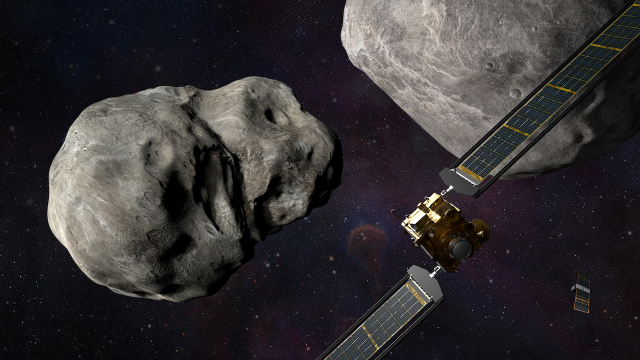NASA’s DART spacecraft has crashed into Dimorphos, with the loss of signal occurring today at exactly 9:14 a.m. AEST as expected. Scientists will now pore over the data to see if the kinetic impactor altered the asteroid’s orbital trajectory.
NASA’s first demonstration of a possible planetary defence strategy appears to have gone exceptionally well, with the DART spacecraft successfully impacting a non-threatening asteroid following a 10-month journey to the Didymos binary asteroid system.
DART’s onboard camera, DRACO (Didymos Reconnaissance and Asteroid Camera for Optical navigation), captured the event in remarkable detail. The camera showed the asteroid coming into view at a rate of one image per second. Surface details, such as rocks, dust, and shadows, got progressively clearer with each new frame. The images kept appearing as DART raced toward Dimorphos at speeds reaching 22,531 km per hour, but it all came crashing to a halt — literally — with a static red screen indicating the loss of signal.
Congratulations on successfully crashing a spacecraft into an asteroid!
— SpaceX (@SpaceX) September 26, 2022
Rarely is the loss of signal a cause for celebration, but today’s test of a kinetic impactor could lead to the development of a planetary defence strategy against threatening asteroids, making DART among the most important missions ever sent to space. The Didymos system poses no threat to Earth, but the system was chosen by NASA due to the ease at which astronomers will be able to measure potential effects of the impact. Predictions suggest that the collision will affect the speed of Dimorphos by a factor of 1%, which should alter its orbit around its larger companion, Didymos. Astronomers should be able to detect this difference with ground-based telescopes.
DART is dead, but the Italian LICIACube lives on, having ejected from the spacecraft several weeks ago. The tiny probe will now investigate the scene, looking for signs of a plume and an impact crater. LICIACube will also attempt to take images of the asteroid’s non-impacting side. Both the Hubble Space Telescope and the Webb Space Telescope were watching for a potential change in Dimorphos’s brightness — a possible indication of how much material was kicked up by the impact. Data gathered by NASA, the European Space Agency, and anyone else watching the event will help scientists determine the composition of Dimorphos’s surface and the degree to which DART affected it.
Indeed, the $US308 ($428) million DART, or Double Asteroid Redirection Test, mission has entered into a new phase. The spacecraft may be gone, but we have a lot of science still ahead of us — and possibly even a viable strategy for deflecting dangerous asteroids.
